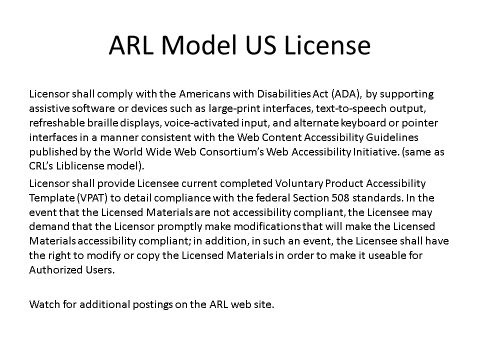Table of Contents
- Accessibility of electronic library resources
- Please tell me about yourselves
- Overview
- I. Introduction
- Meanings of Access\Accessibility in the library world
- Universal Design
- Accessibility standards/guidelines
- Policies pertaining to online accessibility at libraries
- ADA, Title II
- ADA and universally designed IT
- Penn State U -NFB Resolution agreement (Oct. 2011)
- Dear Colleague letter (June 2010)
- University of Montana (2012)
- II. Research on E-resources Selection and Accessibility My spring 2013 sabbatical project
- Factors influencing CD policy and practices
- A. Library CD Policies and Practices
- Collection Policy (example)
- Methodology
- Two sets of campuses
- Major questions
- Some key findings
- The case of Sonoma State University
- Strong commitment and leadership at top administrative level
- The California State University Board of Trustees: Policy on Disability Support and Accommodations - Executive Order Number 926 (2004):
- B . Collection Development Literature Analysis
- Research Questions
- Books on Collection Development
- CD Book examples
- Books on Collection Development
- Accessibility coverage by year (2001-2012)
- Depth of coverage—two positive exceptions
- Curtis (cont.)--recommendations
- Lack of consistency (Curtis)
- Lack of consistency (Wikoff)
- Depth of coverage—extremely brief
- Depth of coverage—unexplained and inadequate
- Depth of coverage—unaware of the need for universal design
- C. Guidance from Professional Organizations
- ALA—a multi-headed entity
- ALA Organizational Structure
- ALA-ACRL and beyond
- Library-related groups which have addressed accessibility of digital content
- Purchasing of Accessible Electronic Resources Resolution ALA Council* Document #52 (Revised 7.14.09)
- Association for Specialized and Cooperative Library Agencies (ASCLA)
- ASCLA "Think Accessible Before You Buy" Toolkit
- ASCLA Blog (Adina Mulliken)
- ALA Digital Content Working Group
- Report of the ARL Joint Task Force on Services to Patrons with Print Disabilities (Nov. 2012)
- Recommendations
- ARL Accessibility and Universal Design Working Group, 2013
- ARL Model US License
- III. Best Practices
- What to ask for?
- Combination
- Required or desirable
- What questions to ask vendors
- Accessibility information from non-vendor sources: Research & other e-resources Info
- Accessibility clearinghouse (my dream)
- Accessibility information from non-vendor sources: Accessibility/usability testing on campus
- From UWSP's CD Policy
- Slide 61
- How to get in touch with me:
Text and Images from Slide
ARL Model US License
Licensor shall comply with the Americans with Disabilities Act (ADA), by supporting assistive software or devices such as large-print interfaces, text-to-speech output, refreshable braille displays, voice-activated input, and alternate keyboard or pointer interfaces in a manner consistent with the Web Content Accessibility Guidelines published by the World Wide Web Consortium's Web Accessibility Initiative. (same as CRL's Liblicense model).
Licensor shall provide Licensee current completed Voluntary Product Accessibility Template (VPAT) to detail compliance with the federal Section 508 standards. In the event that the Licensed Materials are not accessibility compliant, the Licensee may demand that the Licensor promptly make modifications that will make the Licensed Materials accessibility compliant; in addition, in such an event, the Licensee shall have the right to modify or copy the Licensed Materials in order to make it useable for Authorized Users.
Watch for additional postings on the ARL web site.
